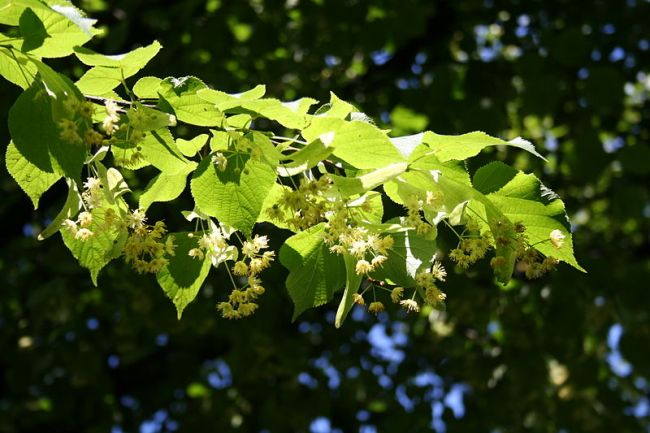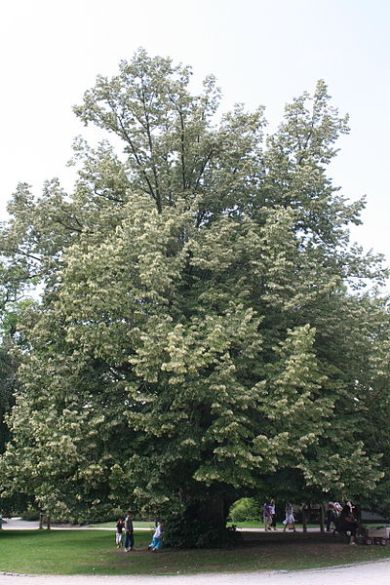
Tilia cordata. Np holmes. Wikimedia Commons.
There is no more romanticized and fragrant flower in June as those of the lime (Tilia) tree. What pleasure it is to walk in city parks at eve, bathed with the scent of the overhanging Lime flowers. It is a European tradition to plant Linden trees near walkways in parks for the June bloom and heavy fragrance they bring. The Germans even have a marked tradition of planting Linden trees over pathways in parks, and the parks and walks under the trees during bloom times are romanticized, ‘unter den linden’. (Forgive my bad German, I was a French student!)
Tilia is a moderate sized genus, having 60 members, of which only about 10 are widely planted. The genus is best represented in Asia, but both European and American species exist that are planted widely. The trees all tend to bloom around the summer solstice in June, with some blooming earlier or later, into autumn. The flowers are normally quite small, but are potently fragrant in some species; being reminiscent of clover and honey. The flowers hang on a leaf-like cluster in some species, adding a strange look to the trees. The trees themselves are also quite impressive, growing to be 60-100 feet tall in many cases, and having lovely heart-shaped leaves, some with silvery undersides. The wood from the trees also yields great wood for woodworking, and is incredibly durable. The wood has been used for making guitars, fibers, even the back of famous icons in the Orthodox Church!
T. americana, Basswood, is an American species, with a wide range over the Eastern U.S. and Southern Canada. Basswood is a widely cultivated tree in these regions, and blooms in midsummer, around the solstice. It yields a nice honey from the fragrant flowers. The flowers can also be used in tea, along with the bark for a variety of homemade medicinal cures.
T. cordata, Little-leaf linden, is native to much of Central Europe, with a wide range north to south and east to west. It is easily the most fragrant of the lindens, and blooms in early June. There are many ancient trees in many parts of Europe of this species, and it is the widest planted tree for street and yard specimens in both Europe and the United States. This tree is also one of, if not the hardiest, down to zone 3.
T. heterophylla is another American native to the Eastern U.S., particularly to the Appalachian mountains. It is distinguished from T. americana by having larger leaves with white, hairy undersides, and larger flowers. T. heterophylla is rarer than T. americana in its native range, and has a smaller crown. The young leaves make a nice herbal tea.
Lastly, T. tomentosa, the silver lime, is another nice specimen linden, native to Southern Europe. It appears like a cross between T. heterophylla and T. americana, with large leaves with silvery undersides. Silver lime is wonderfully and heavily honey scented, blooming earlier than T. americana, and with larger flowers in hanging cymes. It is one of the few with toxic nectar to bees, and several can be found on the ground under these blooming trees, stunned by the nectar.

Tilia tomentosa. Jean-Pol Grandmont. Wikimedia Commons.
While Lindens do make nice specimen plantings, they tend to drop a lot of plant debris and honeydew on anything below them, making for a hellacious cleanup. The flowers tend to bloom for a short window, but one scented walk under them is memorable for an entire lifetime! No wonder they are so beloved in the ranges they will grow, being one of the most useful and scented trees known to the temperate regions.
